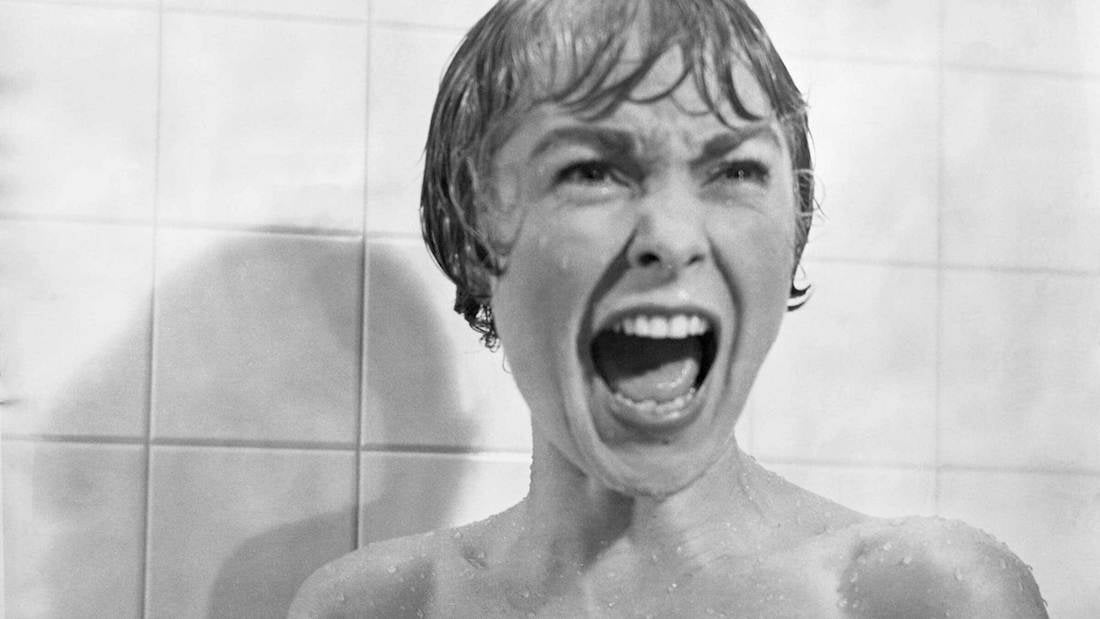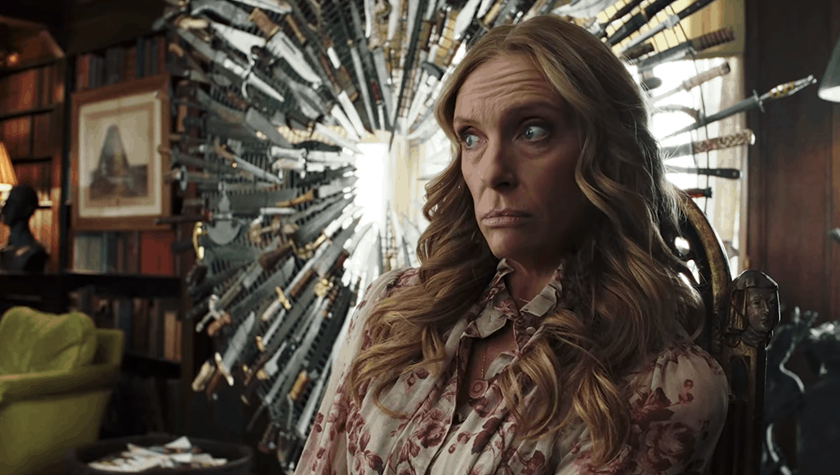All the Write Moves: 'Knives Out'
December 3, 2019
After venturing to a galaxy far, far away by writing and directing Star Wars: The Last Jedi (2017), Rian Johnson returns to his mystery roots with Knives Out, a frothy whodunnit featuring an impressive cast—Daniel Craig, Chris Evans, Jamie Lee Curtis, Michael Shannon, Christopher Plummer, Ana de Armas, and more. A lifelong devotee of mystery storytelling, Johnson launched his feature career with Brick (2005), a film noir set in a high school. With Knives Out, Johnson crafts an homage to legendary mystery novelist Agatha Christie that also vibes with his own distinctive ingenuity.
Set on a lush estate, the movie explores what happens after rich mystery writer Harlan Thrombey (Plummer) dies the day after this 85th birthday. Police, aided by private detective Benoit Blanc (Craig), interrogate Thrombey’s relatives and the members of his household staff in order to determine the truth about Harlan’s death. But as the investigators get closer and closer to solving the mystery, someone at risk of getting discovered uses deadly methods to cover their tracks. Thanks to the precision and wit of Johnson’s script, all of this gets expressed through scenes that are as amusing as they are confounding.
Enter at Your Own Risk
Knives Out offers a textbook example of a craft element that not every screenwriter remembers to utilize—the opening image. Most writers focus their attention on crafting a great opening scene, which might sprawl across multiple pages, but the notion of an opening image is something different. It literally refers to the first thing the viewer sees, and Johnson starts Knives Out with a carefully designed image that perfectly sets the playful mood of the movie.
The shot is a wide angle of the Gothic-looking mansion in which nearly the whole story takes place. The mansion is situated on frame right, and anchoring frame left are the spooky textures of a denuded tree, its branches appearing to hang over the house’s spires like tendrils of a menacing cloud. Drifting across the bottom of the frame are wisps of mist, lending the scene an extra layer of atmosphere. And then Johnson unleashes the element that kicks the opening image into overdrive—two formidable dogs run toward camera in slow motion, imbuing the image with the promise of danger and violence.
Not every movie easily lends itself to an opening image this stylized. Furthermore, not every opening image needs to be this stylized. The jungle treeline that opens Apocalypse Now (1979) is a deceptively simple panorama. The closeup of an eye that opens Avatar (2009) helps ground the FX-driven blockbuster in humanity. But whether you have a piece that would benefit from an elaborate opening image or something more understated, neglecting to explore the possibilities of an opening image is a missed opportunity.
For Knives Out, Johnson either deliberately or intuitively (if not both) crafted an image that combines myriad elements associated with the whodunnit genre. The image has a creepy house, a moody environment, a symbolically resonant weather pattern—and that special something extra; the running dogs that might represent the animal cunning of a murderer whose identity will remain secret until the very end. By packing all of this information into a single shot, Johnson sets a high bar for other writers attempting to start their scripts in high style. Whether you’re just beginning to write a new script or just about to rewrite an existing script, take a lesson from Johnson. Can you contrive a visual metaphor that puts readers in just the right emotional or psychological place to fully appreciate your story?
Takeaway: A great opening image sets the table for the feast that follows.
A Blanc Slate
Arguably the most ingenious sequence in Knives Out is the one that introduces Blanc. One by one, policemen Lieutenant Elliott (LaKeith Stanfield) and Trooper Wagner (Noah Segan) interview the members of the Thrombey family in order to re-create the timeline of the evening of the murder. During each interview, Blanc (played by Craig) lurks in the background, saying nothing even though he occasionally taps a key on the piano next to which he is seated.
Instead of presenting these consecutive interviews in linear order, Johnson plays a delicious game by intercutting them, thus accomplishing two things. First, this technique allows Johnson to juxtapose contradictory remarks, deepening the story’s mystery aspects. Second, it allows several Trombleys to react to Blanc’s presence until one of them finally says what they’re all thinking—words to the effect of, Who the hell is that guy? Which is, of course, exactly the question the audience most wants answered.
However, once Blanc shares his professional credentials, he opens up another mystery by revealing that he doesn’t know who hired him to investigate Harlan Thrombey’s death. He was lured to the case by a cryptic note delivered alongside a stack of cash. In the twisty world of Knives Out, solving one mystery always reveals a second mystery.
And because whodunnits are all about employing misdirection as a storytelling device, the biggest structural benefit of Blanc’s introductory sequence is not immediately apparent. By drawing viewers’ attention to a simple mystery that viewers expect will be solved quickly—the mystery of Blanc’s identity—Johnson discourages viewers from devoting total attention to the stories the Trombleys are telling the police. This allows Johnson to present several important clues in such a way that they drift right by the audience.
Takeaway: If you want to slip something by the audience, use distraction.
In the classic whodunnit formula, a murder occurs early in the story, and then multiple characters emerge as likely suspects. From that point forward, the detective strives to rule out suspects as a means of identifying the killer. This creates two obvious storytelling challenges. First, if the audience closely tracks the detective’s progress, there is a risk of the audience discovering the real killer’s identity too early. Second, if too many suspects get eliminated, the mystery isn’t a mystery anymore. Each writer who tackles this type of narrative approaches these challenges differently, but Johnson’s solutions are as clever as everything else he does in Knives Out.
Alas, very few specifics of what Johnson actually does can be described here without ruining the fun of watching Knives Out, so his technique must be analyzed in a general sense.
Within the story’s first act, Johnson makes a standard mystery-writer move by revealing that a death originally ruled a suicide might actually have been a murder. Then the real games begin. Much earlier in the story than most viewers will expect, Johnson reveals the killer’s identity—sort of. Viewed in retrospect, this beat is a misdirection wrapped inside another misdirection. The trick to making it work is that no single character in the movie ever knows all the relevant facts until the climax. Accordingly, even the character whom we’re led to believe is the story’s mastermind acts out of ignorance.
But that’s not the only sleight of hand Johnson uses. He deftly manipulates audience sympathy so that viewers feel differently toward certain characters as the movie progresses, which has the effect of making it difficult to decide who is a villain and who is a victim. He leads audiences down blind alleys by situating certain characters as possible suspects, when in fact those characters are simply mean-spirited twits, incapable of real criminality. And, perhaps most importantly, Johnson dangles several viable motivations. Depending on the scene, the reason for murder might have been greed, revenge, or something else.
The point is that Johnson doesn’t just replicate the classic whodunnit formula. He bends it, subverts it, and turns it in countless inventive ways. But all the while, he honors the thing that makes whodunnits unique—he invites audiences to participate in the guessing game, and he provides enough clues that once the big secrets are revealed at the end, they make logical sense. By the time the movie is over, the process of elimination has run its course in a way that’s both satisfying and surprising.
Takeaway: A mystery that’s too easy to solve isn’t much fun to watch.
Written by: Peter Hanson
Peter Hanson is a Los Angeles-based writer, filmmaker and teacher. He directed the screenwriting documentary Tales from the Script, and he teaches at Pepperdine University and UCLA Extension. He provides script consulting at www.GrandRiverFilms.com.- Topics:
- Discussing TV & Film




